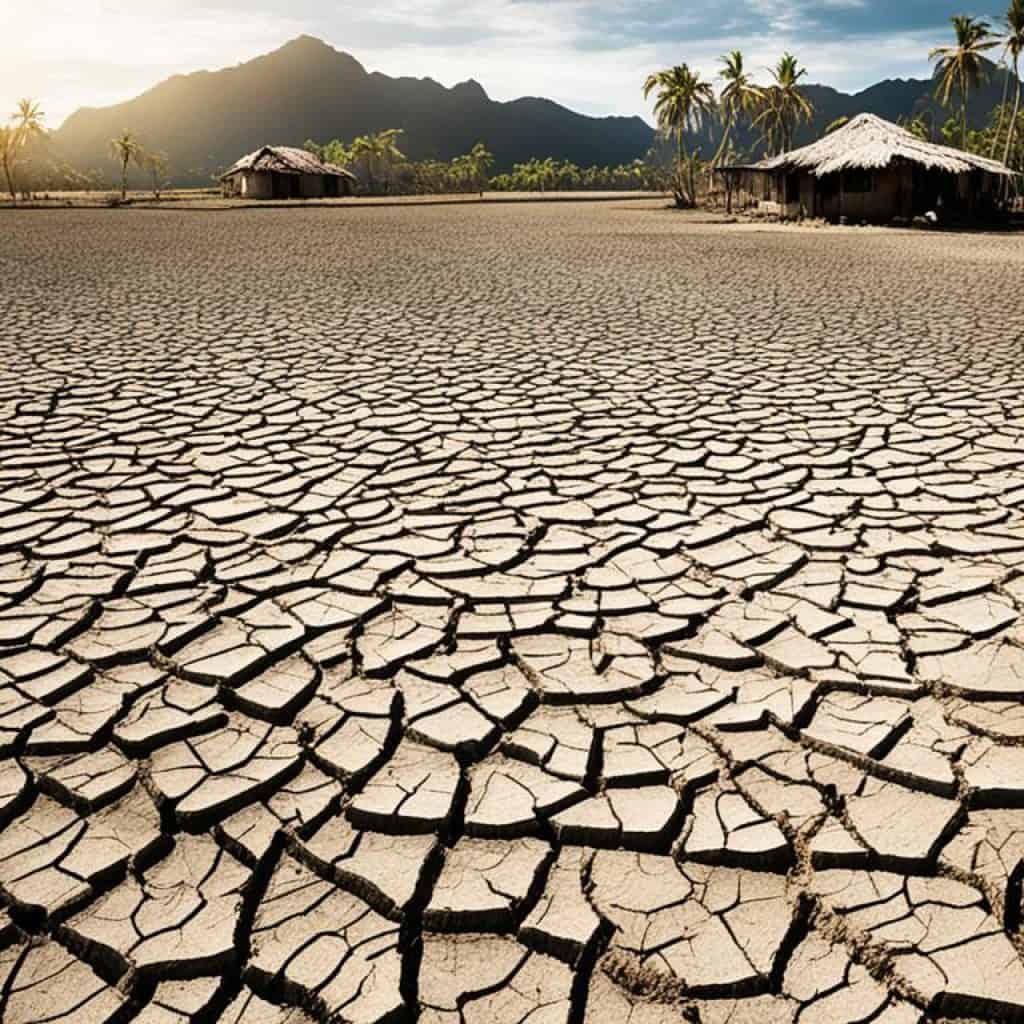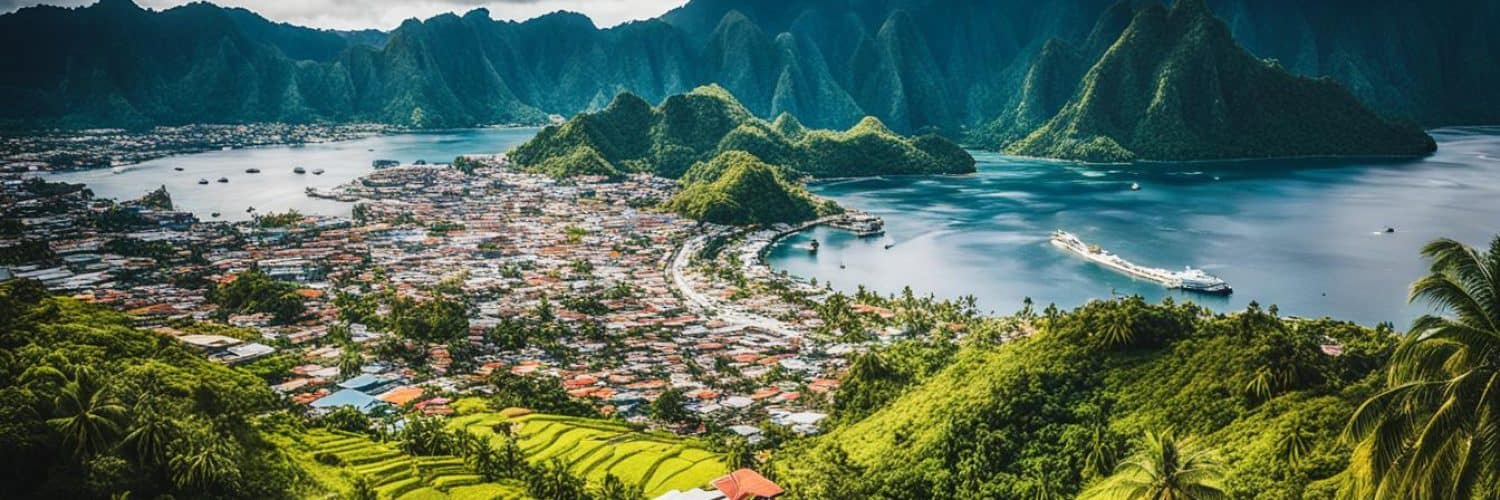When it comes to the weather, the Philippines is known for its tropical climate, but just how hot does it get? Are the temperatures scorching year-round or is there some relief? In this article, we’ll dive into the average temperature in the Philippines, the weather patterns, and the summer heat that locals contend with. Get ready to uncover the truth about the Philippine climate and challenge your preconceptions.
Key Takeaways:
- The Philippines has a tropical climate marked by high temperatures and heavy rainfall.
- The average annual temperature is 27°C, with minimal spatial variation across the country.
- Humidity levels in the Philippines average around 82%.
- The hottest months are April and May, while the coldest months are December, January, and February.
- The country experiences distinct wet and dry seasons influenced by monsoons and tropical cyclones.
Philippine Climate: Geography and Rainfall
The Philippines, an archipelago in Southeast Asia, is known for its tropical maritime climate. While some areas have an equatorial climate with year-round rainfall, most of the country experiences a tropical climate with distinct wet and dry seasons. Let’s explore the geography and rainfall patterns that shape the Philippine climate.
Geography of the Philippines
The Philippines is comprised of over 7,000 islands, creating a diverse geographic landscape. From mountain ranges to coastal plains, the country’s topography influences the distribution of rainfall and temperature variations across regions.
Rainfall in the Philippines
The Philippines receives varying amounts of rainfall throughout the year. The wet season, influenced by the southwest monsoon or “habagat,” typically occurs from May to November. During this season, heavy rainfall is brought to most parts of the archipelago, replenishing water sources and supporting agricultural activities.
The dry season, influenced by the northeast monsoon or “amihan,” usually lasts from December to February. This season is characterized by reduced rainfall and cooler temperatures in some areas.
Table: Average Rainfall in Select Philippine Regions
| Region | Average Annual Rainfall (mm) |
|---|---|
| Metro Manila | 1,800 |
| Iloilo | 2,500 |
| Davao | 2,800 |
| Baguio | 3,100 |
Climate Zones in the Philippines
The Philippines has five main climate zones, each with its own characteristics. These include tropical rainforest, tropical monsoon, tropical savanna, humid subtropical, and oceanic climates. The distribution of these climate zones is determined by factors such as rainfall patterns, temperature, and elevation.
Monsoon Season in the Philippines
The southwest monsoon, known as the “habagat,” brings heavy rainfall during the wet season. This monsoon is responsible for the abundant rainfall and occasional typhoons that affect the Philippines from May to November. On the other hand, the northeast monsoon or “amihan” influences the dry season, bringing cooler temperatures and reduced rainfall to certain areas.
Understanding the geography and rainfall patterns in the Philippines helps us grasp the nuances of its climate and the challenges and benefits it brings to the country. In the next section, we will explore the temperature and humidity levels experienced in the Philippines.
Temperature and Humidity in the Philippines
The Philippines experiences generally high temperatures throughout the year, with an average national temperature of 27°C. In the valleys and plains, temperatures can be even higher. The hottest months in the country are April and May, while the coldest months are December, January, and February. The mean annual temperature is 27.1°C, with minimal spatial variation across the country.
Humidity levels in the Philippines are also high, averaging around 82%. This is due to various factors such as warm moist trade winds, sea surface temperatures, abundant rainfall, and a dense vegetative cover. These elements contribute to the tropical climate of the Philippines.
| Month | Temperature (°C) |
|---|---|
| January | 25.5 |
| February | 26.1 |
| March | 27.3 |
| April | 28.3 |
| May | 28.2 |
| June | 27.4 |
| July | 26.9 |
| August | 26.9 |
| September | 26.9 |
| October | 26.9 |
| November | 26.4 |
| December | 25.9 |
The annual average temperature in the Philippines remains quite stable, with only minimal variations across different locations. This consistent warmth, coupled with the high humidity levels, creates the ideal conditions for the tropical climate found in the country.

Seasonal Temperature Variation
The Philippines experiences a relatively low seasonal temperature variation, with minimal fluctuations between the hottest and coldest months. On average, the temperature difference is approximately 3°C. However, it’s important to note that there can be variation based on elevation.
One example of elevation impacting temperature is Baguio City, which is located at a higher elevation. In Baguio City, the daily mean temperature is 19.6°C, making it cooler compared to other parts of the country.
Overall, the temperature in the Philippines remains relatively constant throughout the year, with only negligible fluctuations. This stability in temperature contributes to the country’s tropical climate and makes it an ideal destination for year-round travel and outdoor activities.
Regional Variation in Rainfall
When it comes to rainfall, the Philippines exhibits significant regional variations in precipitation distribution. The country’s diverse geography plays a crucial role in shaping these differences. From June to September, heavy rainfall is concentrated in the western regions, while from October to March, the eastern regions experience the bulk of the rainfall.
The Philippines’ mountainous terrain and narrow coastal plains contribute to convective rainfall patterns, leading to varying levels of precipitation across different areas. For instance, cities like Legazpi receive over 3,000 mm of rainfall annually, while other regions may receive less.
“Rainfall distribution in the Philippines is influenced by the country’s unique topography, resulting in significant geographical variations in precipitation.”
To provide a better understanding of the rainfall distribution across different regions of the Philippines, here’s a table showcasing the annual precipitation levels in selected locations:
| City | Annual Precipitation (mm) |
|---|---|
| Manila | 2,086 |
| Bacolod | 2,446 |
| Legazpi | 3,143 |
| Cebu | 1,754 |
| Cagayan de Oro | 2,817 |
As the table shows, different cities in the Philippines experience varying levels of precipitation throughout the year. These regional variations in rainfall contribute to the country’s distinct climates and ecosystems.
Impact of Monsoons and Tropical Cyclones
The Philippines is located in an area highly prone to the effects of monsoons and tropical cyclones, which significantly impact the country’s weather patterns and climate.
The southwestern monsoons, also known as the Habagat, bring heavy rainfall during the summer months. These monsoons, originating from warm ocean currents, result in frequent showers and thunderstorms across the archipelago. The intense precipitation brought by the monsoons contributes to the country’s overall annual rainfall.
On the other hand, the northeastern monsoon, locally referred to as the Amihan, and tropical cyclones are responsible for the winter precipitation in the Philippines. While not as prevalent as the southwestern monsoons, these weather systems still play a crucial role in affecting the country’s weather patterns.
“At least 30% of the annual rainfall in the northern Philippines can be attributed to tropical cyclones, which underscores their significance in shaping the country’s climate.”
The country experiences an average of 28 storms or typhoons entering the Philippine area of responsibility each year. These tropical cyclones can bring destructive winds, intense rainfall, storm surges, and even flooding. One of the most devastating typhoons in recent history was Typhoon Haiyan in 2013, which caused widespread devastation and loss of life.
The impact of monsoons and tropical cyclones is far-reaching, affecting various sectors such as agriculture, infrastructure, and livelihoods. These weather events can disrupt transportation systems, damage crops, and pose risks to human safety. The government, along with meteorological agencies like the Philippine Atmospheric, Geophysical and Astronomical Services Administration (PAGASA), closely monitors and provides timely warnings and information to mitigate the effects of these weather phenomena.
| Tropical Cyclone | Year | Damage (Estimated) |
|---|---|---|
| Typhoon Haiyan (Yolanda) | 2013 | $2.2 billion |
| Typhoon Mangkhut (Ompong) | 2018 | $705 million |
| Typhoon Ketsana (Ondoy) | 2009 | $1.09 billion |
It is crucial for the Philippines to continue building resilient infrastructure, improving early warning systems, and implementing disaster risk reduction strategies to mitigate the impact of monsoons and tropical cyclones. By doing so, the country can enhance its ability to withstand and recover from the adverse effects of these weather events, ultimately ensuring the safety and well-being of its population.
Effects of El Niño and Droughts
The Philippines is no stranger to the impacts of El Niño, a climate phenomenon that has significant effects on the country’s weather patterns. El Niño occurs when there is a prolonged warming of the central and eastern tropical Pacific Ocean, leading to shifts in atmospheric circulation and rainfall patterns.
During El Niño events, the Philippines experiences reduced rainfall and extended periods of drought. This has severe consequences for various sectors, particularly in agriculture, where crops and livestock are heavily dependent on adequate water supply. Drought conditions can lead to crop failures, loss of livestock, and reduced agricultural productivity, affecting food security and livelihoods.
The effects of El Niño extend beyond the agricultural sector. Water supply systems can also be severely impacted, as water sources such as rivers, lakes, and reservoirs experience lower water levels. This can lead to water shortages for domestic, industrial, and commercial use, further exacerbating the challenges faced during droughts.
Additionally, El Niño-induced droughts can have far-reaching socioeconomic consequences. For instance, reduced agricultural output and water scarcity can result in increased food prices, affecting both consumers and businesses. The livelihoods of farmers, fisherfolk, and other rural communities can be significantly disrupted, as they rely heavily on agricultural activities for their income and sustenance.
Efforts to mitigate the effects of El Niño and droughts in the Philippines involve proactive management and adaptation measures. These include the implementation of early warning systems, water conservation campaigns, and the development of drought-resistant crops. The government and various organizations also provide assistance and support to affected communities, such as access to alternative livelihood opportunities, drought-resistant seeds, and financial aid.
“El Niño events can pose significant challenges to the Philippines, but with proper planning and mitigation strategies, we can minimize their impacts on our communities and safeguard our resources.”
It is crucial for the Philippines to continually monitor and study El Niño patterns and their potential impacts. This helps in developing more effective strategies and policies to address the challenges posed by these climate phenomena. Combined efforts of government agencies, scientific institutions, communities, and individuals are crucial in building resilience and ensuring the sustainable development of the country.

The Impact of El Niño on Key Sectors
El Niño events and the resulting droughts can have significant consequences for key sectors in the Philippines:
| Sector | Impact |
|---|---|
| Agriculture | Reduced crop yield, livestock losses, decreased agricultural productivity |
| Water Supply | Water shortages, decreased water levels in rivers, lakes, and reservoirs |
| Food Security | Increased food prices, limited availability, decreased accessibility |
| Rural Livelihoods | Disruption of farming and fishing activities, income loss, reduced livelihood opportunities |
| Economic Stability | Impact on businesses, reduced economic growth in affected areas |
Warmest and Coolest Months
In the Philippines, the warmest months are April and May. During this time, temperatures reach their highest levels, providing a perfect opportunity for beach lovers to soak up the sun and enjoy the country’s beautiful coastlines. With clear blue skies and warm waters, these months attract tourists looking for a tropical getaway.
On the other hand, the coolest months in the Philippines are December, January, and February. Though the temperatures may be slightly lower during this period, they still offer a pleasant and comfortable climate for visitors. It is an ideal time to explore the country’s numerous cultural and historical sites, as well as enjoy outdoor activities.
It’s important to note that while there is a distinction between the warmest and coolest months in the Philippines, the temperature variation throughout the year is minimal. The country enjoys a relatively constant average temperature, making it an inviting destination for travelers seeking a tropical climate.
Climate Variation by Region
The Philippines is known for its diverse climate, influenced by its geographic location and varied topography. Different regions across the country experience variations in temperature and rainfall patterns, resulting in a climate diversity that adds to the charm and uniqueness of the Philippines.
In the northern and eastern parts of the country, the climate is primarily influenced by the northeast monsoon. These regions tend to receive more rainfall compared to the western regions, which are more affected by the southwest monsoon.
Additionally, regional factors such as elevation and proximity to bodies of water contribute to the climate variation within the country. Higher elevation areas, like the mountainous regions of Luzon, experience cooler temperatures compared to low-lying coastal areas.
Here is a table showcasing the regional climate variation in the Philippines:
| Region | Main Influencing Factors |
|---|---|
| Northern Luzon | Northeast monsoon Higher rainfall |
| Southern Luzon | Southwest monsoon Lower rainfall |
| Visayas | Trade winds and monsoons Moderate rainfall |
| Mindanao | Trade winds and monsoons Moderate to high rainfall |
This regional variation in climate adds to the diversity of ecosystems and landscapes found in the Philippines. From lush rainforests to pristine beaches, travelers can explore a wide range of environments within one country.

Discovering the regional climate variation in the Philippines is a fascinating journey that allows you to experience the different facets of this beautiful country. Whether you prefer cooler temperatures in the northern regions or the tropical warmth of the southern islands, the Philippines has something for everyone.
Climate Zones in the Philippines
The Philippines is home to diverse climate zones that contribute to the rich biodiversity and varying landscapes of the archipelago. The country can be classified into five main climate types, each characterized by distinct weather patterns, temperatures, and rainfall:
- Tropical Rainforest Climate: This climate zone is characterized by high temperatures, usually above 18°C throughout the year, and abundant rainfall, often exceeding 2,000 millimeters annually. The dense rainforests of Palawan and Mindanao are examples of areas with a tropical rainforest climate.
- Tropical Monsoon Climate: The tropical monsoon climate is characterized by distinct wet and dry seasons. It is prevalent in the western parts of the country, including areas such as Manila. The wet season typically occurs from May to October, with heavy rainfall brought by the southwest monsoon, while the dry season runs from November to April.
- Tropical Savanna Climate: This climate zone is characterized by a distinct dry season and a shorter wet season. The temperature remains relatively high throughout the year, and rainfall is lower compared to the tropical monsoon climate. The Cagayan Valley in northern Luzon is an example of an area with a tropical savanna climate.
- Humid Subtropical Climate: Found in highland regions such as Baguio City, the humid subtropical climate is characterized by cooler temperatures compared to other parts of the country. Summers are mild, while winters can be colder, with occasional frosts. Rainfall is evenly distributed throughout the year, although it tends to be higher during the typhoon season.
- Oceanic Climate: This climate zone is mainly experienced in the Batanes Islands, located in the northernmost part of the country. The oceanic climate is characterized by mild temperatures, high humidity, and rainfall distributed throughout the year. Winters are relatively cooler, with January and February as the coldest months.
The distribution of these climate zones is influenced by various factors, including the Philippines’ geographical location, topography, and its proximity to bodies of water. These climate zones contribute to the rich biodiversity and unique ecosystems found in the Philippines, making it a haven for diverse flora and fauna.
| Climate Zone | Main Characteristics | Example Locations |
|---|---|---|
| Tropical Rainforest | High temperatures, abundant rainfall | Palawan, Mindanao |
| Tropical Monsoon | Distinct wet and dry seasons, heavy rainfall | Manila, Cebu |
| Tropical Savanna | Dry and wet seasons, lower rainfall | Cagayan Valley |
| Humid Subtropical | Cooler temperatures, even rainfall | Baguio City, Benguet |
| Oceanic | Mild temperatures, high humidity | Batanes Islands |
The diverse climate zones of the Philippines create a fascinating tapestry of habitats and contribute to the country’s exceptional natural beauty. From the lush rainforests to the picturesque highlands, each climate zone offers a unique and captivating experience for explorers and nature enthusiasts.
Weather Monitoring and Forecasting in the Philippines
The Philippine Atmospheric, Geophysical and Astronomical Services Administration (PAGASA) is responsible for monitoring and managing weather conditions in the Philippines. This government agency plays a crucial role in providing accurate and timely weather forecasts, storm warnings, and valuable climate information.
PAGASA utilizes advanced technology and data analysis to gather and interpret weather data from various sources. This includes satellite imagery, weather stations, and radar systems, which enable them to track weather patterns and predict changes in the atmospheric conditions.
Through the use of sophisticated computer models and algorithms, PAGASA generates weather forecasts that cover a wide range of timeframes, from short-term predictions to long-range outlooks. These forecasts help individuals and businesses make informed decisions and take necessary precautions based on the expected weather conditions.
One of the key focuses of PAGASA is to ensure the safety and well-being of the population. By providing accurate storm warnings, PAGASA helps communities prepare for potentially hazardous weather events such as typhoons, heavy rainfall, and strong winds. This proactive approach enables authorities to implement necessary measures to mitigate the impact of adverse weather conditions on public safety and infrastructure.
PAGASA’s weather forecasts and climate information are accessible to the public through various channels, including their website, mobile applications, and traditional media outlets. This widespread dissemination of weather information allows individuals, businesses, and government agencies to stay updated on the latest weather conditions and make informed decisions accordingly.
Overall, PAGASA’s continuous efforts in weather monitoring and forecasting contribute to a safer and more resilient Philippines. By leveraging technology, data analysis, and scientific expertise, PAGASA plays a vital role in protecting lives, safeguarding infrastructure, and ensuring the sustainable development of the country.
Benefits of Weather Monitoring and Forecasting
Accurate weather monitoring and forecasting provide numerous benefits to individuals, communities, and industries in the Philippines. Here are some key advantages:
- Early warning systems: Weather forecasts enable communities to prepare for and respond to potentially hazardous weather events in a timely manner, minimizing the risks to life and property.
- Planning and decision-making: Businesses and industries can make informed decisions based on weather forecasts, optimizing operations, resource allocation, and supply chain management.
- Agriculture and farming: Farmers can use weather forecasts to plan their agricultural activities, such as planting, harvesting, and irrigation, ensuring optimal yield and reducing crop losses.
- Tourism and recreation: Weather forecasts allow travelers and tourism operators to plan trips and outdoor activities, maximizing their enjoyment and ensuring safety in various destinations.
- Disaster preparedness and response: Government agencies and organizations involved in disaster management can utilize weather forecasts to develop preparedness plans, allocate resources, and coordinate emergency response efforts.
Weather monitoring and forecasting, facilitated by agencies like PAGASA, is an essential component of building climate resilience and adapting to the ever-changing weather patterns. By leveraging scientific knowledge and technological advancements, the Philippines can better prepare for and manage weather-related challenges, ensuring the overall security and well-being of its population.
| Benefits of Weather Monitoring and Forecasting | Examples |
|---|---|
| Early warning systems | To prevent casualties and evacuate areas prone to flooding or landslides. |
| Planning and decision-making | To optimize construction schedules, agricultural activities, and transportation logistics. |
| Agriculture and farming | To determine the best times for planting, irrigation, and pest control in agricultural regions. |
| Tourism and recreation | To help tourists plan outdoor activities, choose suitable destinations, and ensure their safety. |
| Disaster preparedness and response | To coordinate emergency services, distribute resources, and plan evacuations during natural disasters. |
Factors Affecting Philippine Weather
Several factors contribute to the weather patterns in the Philippines. These include the trade winds, sea surface temperatures, topography, ocean currents, and the influence of surrounding land masses. The interaction of these factors creates the distinct climate patterns experienced in the country, including the monsoons and tropical cyclones that impact the weather throughout the year.
Conclusion
The climate in the Philippines is characterized by high temperatures, heavy rainfall, and humidity. The country experiences distinct wet and dry seasons, with the hottest months being April and May. Regional variations in rainfall and temperature can be observed, but overall, the temperature remains relatively constant throughout the year. The influence of monsoons and tropical cyclones also impacts the weather patterns in the country. Continued monitoring and management of weather patterns are essential to ensure the safety and well-being of the population.
In conclusion, the Philippines climate offers a unique blend of tropical characteristics. With its high temperatures, heavy rainfall, and high humidity levels, the country’s climate is influenced by various factors such as monsoons and tropical cyclones. While there are regional variations in rainfall and temperature, the overall climate remains relatively consistent throughout the year. The Philippines’ weather patterns require monitoring and management to safeguard the population and support their well-being in the face of changing environmental conditions.
Conclusion
In conclusion, the Philippines is known for its tropical climate, characterized by high temperatures, heavy rainfall, and high humidity levels. The country experiences distinct wet and dry seasons, with the hottest months being April and May. During these months, the temperature rises, and the heat can be intense. However, overall, the temperature remains relatively constant throughout the year, with minimal seasonal variations.
Regional variations in temperature and rainfall exist, with some areas receiving more rainfall than others. These variations are influenced by factors such as elevation, proximity to bodies of water, and the effects of monsoons and tropical cyclones. The Philippines is located in a region prone to typhoons and cyclones, which bring heavy rainfall and strong winds.
Monitoring and managing weather conditions are crucial for the safety and well-being of the population. The Philippine Atmospheric, Geophysical and Astronomical Services Administration (PAGASA) plays a vital role in providing accurate weather forecasts, storm warnings, and climate information. By staying informed and prepared, individuals and communities can adapt to the changing weather patterns and mitigate potential risks.
Understanding the climate and weather patterns in the Philippines is essential for various sectors, including agriculture, tourism, and urban planning. By considering the climate’s influence and implementing appropriate strategies, the country can harness its natural resources, protect its citizens, and foster sustainable development. Overall, the unique climate of the Philippines shapes its environment, culture, and way of life.


















Add comment